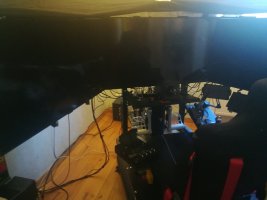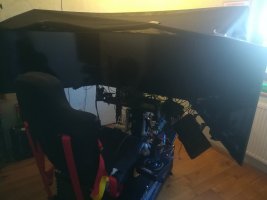I tried the V3, and it was way too brutal, and unnatural.
To really really enjoy a motion simulator, I came to the conclusion to get a Hexapod.
The size of the hexapod decides how much it can simulate G-Forces, and these kind of effects need motion compensation. The Cruden Hexapod was too big for me, and way too expensive.
Gforces cannot be simulated by the kind of D-Box systems. They are very usefull when it comes to calibrating the braking. Braking without gforces feels like stepping on a dead braking pedal without braking fluid in a real car...
On the other hand, a Hexapod cannot simulate roadrumbles of vertical actuators. Not a big deal, I use bass-shakers for those effects.
It's short motion effects are less brutal than a seat mover, but I did not like at all how the V3 slaps my back of the head, when I brake, the head is pushed back, and the back of the seat hits the head forward, That is a false cue, the most common false cue, which not many people are aware of, and the most difficult to avoid, specially on short curvy tracks with high power cars (F1 in Monaco). Before feeling the braking, you feel a short moment of acceleration when braking...
Qubic system does only allow one large screen, or small triple 32"screens .
Not a big deal if you use VR, but VR can be less spontaneous to start a quick session.
All moving parts are open and edgy, not very secure, if kids are standing around...
and really no place left to fix controllers.
It's 20K to 26k to 30k...
So I want to raise your attention to the Edge6D,
https://www.gforcefactory.com/
The platform cost me about 12.500€, and I could add 3 43" Screens on the platform. I mounted a very light weed blocker around to have a cockpit feeling, because the platform can move so much, (the intensity is adjustable with a volume knob) it made me sick when the light was on, and I could see the edges of the wall and ceiling tilt and roll behind my screens.
I own it for 6month, and has a virtual tracker for the motion compensation,
meaning the motion of the platform is directly send to the motion compensation via a FlyPT module.
VR motion compensation is still experimental programmed by a single person, Dschadu, not by platform producers and not by the headset producers. Oculus makes it more difficult to use, as it does not allow overlays. The sims have to be forced to run in SteamVR, it works with openVR, I haven't tried yet OpenXR. It's a bit tricky to setup with a Quest2, who sometimes looses track depending on the brightness of the main screen or the room.
The Edge6D is silent, you hear more the large screens screech on sudden motion changes, than the actuators of the platform.
I managed to fix all controllers for flight (X-56 Stick and Throttle) and racing simulations simultaneously. (Handbrake sequential shifter, H-Shifter.
I only need to remove the big Thrustmaster TFRP Rudder which I can fix with 2 screws on the plate in front of the Invicta pedals in less than a minute.
It's incredible how I could place flight controllers side by side to racing controllers, and touchscreens on each side. All connected to a USB hub on the platform, only 4 cables leave the rig to the PC, 1 USB and 3HDMI.
It took me a year to check and try most kind of simulators, including the NLR systems, which, complete, cost more, and are simply bad with very unstable rolls and still no surge, the very expensive
https://elektrax.com, very brutal, like the V3, but with TL, which can hardly be used for flight sim. Same for the Tracktime 3DOF, too expensive, 1 screen,
https://simracing-store.com/int/simulatoren/komplett-systeme/tracktime-3motion.
The Edge6D is the best compromise, in space, in motion, in security, in noise, in maintainance costs, in performance both in racing and flying, and finally in price!
The Edge6D is a wonderfull piece of engineering, with excellent TL, no technical problem at all, and a high standard of security, no open parts in motion.
Support is great!












